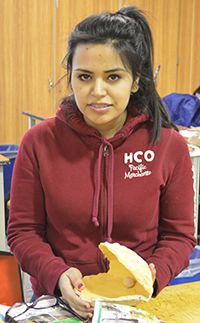Chau Le’s paper printmaking box is decorated with an intricate pattern of dreamcatchers and crosses. The Kelloggsville High School sophomore said the pictures symbolize her hopes for others: Dare to dream and have faith.
Chau moved to the United States from Vietnam seven years ago. For her and other immigrant students, part of her progress acclimating to life in America has happened in the art room. There, she uses different mediums to express herself in ways she’s not comfortable verbalizing in English.
“I believe that art is a special communication that is used around the world without the need of learning a different language,” Chau said.
High school art teacher Donna Casmere teaches all her students what Chau has learned: Art is a universal language.
She tells Chau and other English-language learner students to use their paintbrushes, pens and clay as conduits for the messages they want to convey.
After all, pictures, they say, are worth a thousand words.
“They have the language of self-expression and telling their story through pictures and images,” Casmere said.

Art As Expression
In Kelloggsville, 21 percent of students are non-native English speakers. Casmere helps develop their communication skills through art that touches the community, through demonstrations, and by showing them how art relates to history and science.
“I truly love being able to demonstrate, and have them see what it is that I am talking about,” she sad. “For example, students learn basics like colors and shapes and are able to show what they are doing without words and with actions.”
She can teach history related to the ancient printmaking technique the students used on their paper boxes, or science while firing clay. Students write narratives to explain their work. Art makes the information understandable for students learning English.
Casmere sees how all children can develop and shine through art.
“I think it’s the essence for growth,” she added. “The first thing a child ever writes is a drawing. It’s a scribble or a mark and that evolves into writing.”
Speaking Through their Art
ELL students said art has helped them improve their English, build confidence, consider possibilities and take risks. When they are lost for words, they can say what they want through their projects.
How Art Helps English-language Learner Students Communicate
|
“This is the first year that I’d decided to take art in school, and it turns out to be one of the best decisions I’ve made,” Chau said. “Thanks to Mrs. Casmere, I was able to have the opportunity to learn so many ways of art that I would never have known before. Art has made me look at everything differently, from the people who I see to the action that I choose to do.”
‘Art showed me a new world, more than just studying.’ — Linh Le
Linh Le came from Vietnam in eighth grade. She excelled in school, working very hard to learn English. But it wasn’t until the district’s Kelloggsville Community Pride festival her freshman year, she said, that she she felt she truly fit in. She volunteered to paint children’s faces, and many festival goers admired her artistic ability. She’s taken art classes every year since, even winning a Michigan Art Education Association state award.
“I love art so much,” Linh said. “Back then I could not communicate or talk to anyone at all, and through art I could express myself.
“I think art gave me confidence. Art showed me a new world, more than just studying. I could do different activities.”
Linh now volunteers with students at Kids’Art Camp, led by Casmere, plays tennis, tutors and provides translation for other students. She helps Vietnamese juniors Nhi Nguyen, who immigrated 18 months ago, and Thu Nguyen, who arrived just six months ago.

‘To Show My Emotions So They Can Understand Me’
Nhi said, in a written piece, that art has helped her learn and understand English.
“Art helps me express myself in any shape or form without words or actions,” Nhi said. “Art sometimes helps me understand the depth of words or things, to see the open-mindedness of life. I think art is a common language for all people in the world.”
Thu wrote that she thinks of what she wants her work to communicate to others.
“Art is my life and like a second language I speak. … I think about what exactly I want to draw, how I will show my emotions to everyone so they can understand me.”
Kelloggsville High School ELL teacher Susan Faulk said art is also a way for her students to relax.

“For Thu, art has been her saving grace,” Faulk said. “It is one hour a day when her brain doesn’t have to work so hard, when she doesn’t have to focus so much on learning English and learning difficult academic concepts. She is able to lose herself in her art, lose herself in expressing her emotions.
“It gives her an outlet for expressing her emotions when she doesn’t have the English words to do it verbally.”
For Cecilia Leyva, a junior from Mexico, art is a way to show her vibrant personality and love for her heritage through bold, colorful pieces. She explained what art means to her and other U.S. newcomers.
“We don’t find a way how to say it,” Cecilia said, “but by drawing and doing projects we can let it all out.”









